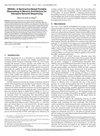利用MLP栈分析和开发内存层次并行性
IF 1.4
3区 计算机科学
Q4 COMPUTER SCIENCE, HARDWARE & ARCHITECTURE
引用次数: 0
摘要
在现代cpu上获得高指令吞吐量需要生成高度的内存级并行性(MLP)。MLP通常作为DRAM级别的定量度量来报告。然而,理解阻碍内存并行性的原因需要更有洞察力的指标和可视化。本文提出了一种新的MLP度量分类法,将MLP划分为核心和预取组件,并测量未命中和命中缓存级并行性。我们的主要贡献是一个MLP堆栈,一个集成这些指标的可视化,并通过显示每个内存级别的CPI贡献将其与性能联系起来。该堆栈还显示了依赖绑定和结构危险绑定负载的推测并行性。我们在处理器模拟器中实现了MLP堆栈,并进行了案例研究,以展示针对软件优化(例如,软件预取)和硬件改进(例如,指令窗口大小)的潜力。本文章由计算机程序翻译,如有差异,请以英文原文为准。
Analyzing and Exploiting Memory Hierarchy Parallelism With MLP Stacks
Obtaining high instruction throughput on modern CPUs requires generating a high degree of memory-level parallelism (MLP). MLP is typically reported as a quantitative metric at the DRAM level. However, understanding the reasons that hinder memory parallelism requires more insightful metrics and visualizations. This paper proposes a new taxonomy of MLP metrics, splitting MLP into core and prefetch components and measuring both miss and hit cache level parallelism. Our key contribution is an MLP stack, a visualization that integrates these metrics, and connects then to performance by showing the CPI contribution of each memory level. The stack also shows speculative parallelism from dependency-bound and structural-hazard-bound loads. We implement the MLP stack in a processor simulator and conduct case studies that demonstrate the potential for targeting software optimizations (e.g., software prefetching), and hardware improvements (e.g., instruction window sizing).
求助全文
通过发布文献求助,成功后即可免费获取论文全文。
去求助
来源期刊

IEEE Computer Architecture Letters
COMPUTER SCIENCE, HARDWARE & ARCHITECTURE-
CiteScore
4.60
自引率
4.30%
发文量
29
期刊介绍:
IEEE Computer Architecture Letters is a rigorously peer-reviewed forum for publishing early, high-impact results in the areas of uni- and multiprocessor computer systems, computer architecture, microarchitecture, workload characterization, performance evaluation and simulation techniques, and power-aware computing. Submissions are welcomed on any topic in computer architecture, especially but not limited to: microprocessor and multiprocessor systems, microarchitecture and ILP processors, workload characterization, performance evaluation and simulation techniques, compiler-hardware and operating system-hardware interactions, interconnect architectures, memory and cache systems, power and thermal issues at the architecture level, I/O architectures and techniques, independent validation of previously published results, analysis of unsuccessful techniques, domain-specific processor architectures (e.g., embedded, graphics, network, etc.), real-time and high-availability architectures, reconfigurable systems.
 求助内容:
求助内容: 应助结果提醒方式:
应助结果提醒方式:


